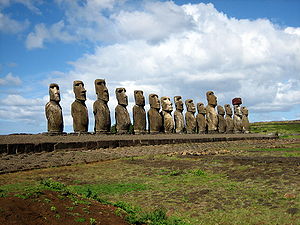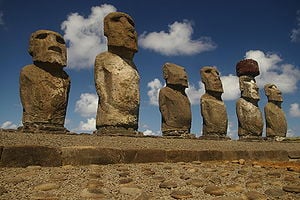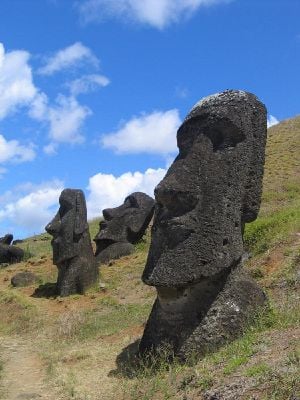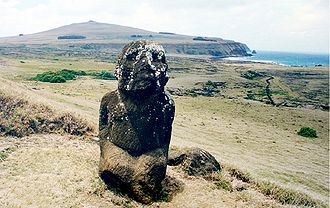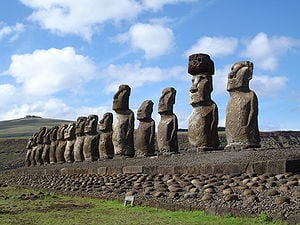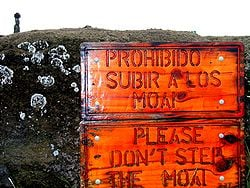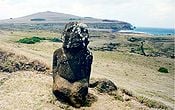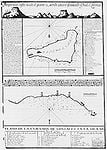Moai
Moai, or mo‘ai, are monolithic human figures carved from rock on the Chilean Polynesian island of Easter Island between the years 1250 and 1500. Nearly half are still at Rano Raraku, the main moai quarry, but hundreds were transported from there and set on stone platforms called ahu around the island's perimeter. Almost all moai have overly large heads three-fifths the size of their bodies.
Description
The moai are monolithic statues, their minimalist style related to forms found throughout Polynesia. Moai are carved in relatively flat planes, the faces bearing proud but enigmatic expressions. The over-large heads (a three-to-five ratio between the head and the body, a sculptural trait that demonstrates the Polynesian belief in the sanctity of the chiefly head) have heavy brows and elongated noses with a distinctive fish-hook-shaped curl of the nostrils. The lips protrude in a thin pout. Like the nose, the ears are elongated and oblong in form. The jaw lines stand out against the truncated neck. The torsos are heavy, and, sometimes, the clavicles are subtly outlined in stone. The arms are carved in bas relief and rest against the body in various positions, hands and long slender fingers resting along the crests of the hips, meeting at the hami (loincloth), with the thumbs sometimes pointing towards the navel. Generally, the anatomical features of the backs are not detailed, but sometimes bear a ring and girdle motif on the buttocks and lower back. Except for one kneeling moai, the statues do not have legs.
Though moai are whole-body statues, they are commonly referred to as "Easter Island heads." This is partly because of the disproportionate size of most moai heads and partly because, from the invention of photography until the 1950s, the only moai standing on the island were the statues on the slopes of Rano Raraku, many of which are buried to their shoulders. Some of the "heads" at Rano Raraku have been excavated and their bodies seen, and observed to have markings that had been protected from erosion by their burial.
All but 53 of the 887 moai known to date were carved from tuff (a compressed volcanic ash). At the end of carving, the builders would rub the statue with pumice from Rano Raraku, where 394 moai and incomplete moai are still visible today (there are also 13 moai carved from basalt, 22 from trachyte and 17 from fragile red scoria).[1]
Many of the moai were transported to and installed on an ahu—a stone pedestal upon which several moai were mounted, facing inland across the island. However, a larger proportion were found still in the quarries (397 moai); 288 were successfully transported to a variety of ahus; and 92 have been located somewhere outside of the quarry area, apparently in transit to an ahu.[1]
Moai range in size from a height of less than 1.5 meters (4.9 ft) to around 10 meters (33 ft) tall. The tallest moai erected, called Paro, was 9.2 meters (30 ft) high and weighed 82 tons; the largest that fell while being erected was 9.94 meters (32.6 ft); and the largest (unfinished) moai, found at the Rano Raraku Quarry and named El Gigante, would have been 21.6 meters (71 ft) tall with a weight of about 150 tons.[2]
Tukuturi is an unusual moai. Its beard and kneeling posture distinguish it from standard moai.
Tukuturi is made of red scoria from Puna Pau, but sits at Rano Raraku, the tuff quarry. It is possibly related to the Tangata manu cult, in which case it would be one of the last moai ever made.[3]
Easter Island moai are known for their large, broad noses and strong chins, along with rectangle-shaped ears and deep eye slits.
Eyes
In 1979, Sergio Rapu Haoa and a team of archaeologists discovered that the hemispherical or deep elliptical eye sockets were designed to hold coral eyes with either black obsidian or red scoria pupils. The discovery was made by collecting and reassembling broken fragments of white coral that were found at the various sites. Subsequently, previously uncategorized finds in the Easter Island museum were re-examined and recategorized as eye fragments. It is thought that the moai with carved eye sockets were probably allocated to the ahu and ceremonial sites, suggesting that a selective Rapa Nui hierarchy was attributed to the moai design until its demise with the advent of the Birdman religion, Tangata Manu.
Pukao topknots and headdresses
Some moai had pukao on their heads; these were carved out of red scoria, a very light rock from a quarry at Puna Pau.
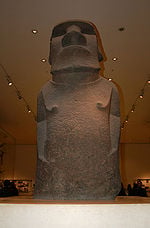
Markings (post stone working)
When first carved, the surface of the moai was polished smooth by rubbing with pumice. Unfortunately, the easily worked tuff from which most moai were carved is also easily eroded, and, today, the best place to see the surface detail is on the few moai carved from basalt or in photographs and other archaeological records of moai surfaces protected by burial.
Those moai that are less eroded typically have designs carved on their backs and posteriors. The Routledge expedition of 1914 established a cultural link[4] between these designs and the island's traditional tattooing, which had been repressed by missionaries a half-century earlier. Until modern DNA analysis of the islanders and their ancestors, this was key scientific evidence that the moai had been carved by the Rapa Nui and not by a separate group from South America.
At least some of the moai were painted; Hoa Hakananai'a was decorated with maroon and white paint until 1868, when it was removed from the island. It is now housed in the British Museum, London.
History

The statues were carved by the Polynesian colonizers of the island, mostly between circa 1250 C.E. and 1500 C.E.[5]
Completed statues were moved to ahu mostly on the coast, then erected, sometimes with red stone cylinders (pukao) on their heads. Moai must have been extremely expensive to craft and transport; not only would the actual carving of each statue require effort and resources, but the finished product was then hauled to its final location and erected.
The quarries in Rano Raraku appear to have been abandoned abruptly, with a litter of stone tools, many completed moai outside the quarry awaiting transport and almost as many incomplete statues still in situ as were installed on ahu. In the nineteenth century, this led to conjecture that the island was the remnant of a sunken continent and that most completed moai were under the sea. That idea has long been debunked, and now it is understood that:
- Some statues were rock carvings and never intended to be completed.
- Some were incomplete because, when inclusions were encountered, the carvers would abandon a partial statue and start a new one[6] (tuff is a soft rock with occasional lumps of much harder rock included in it).
- Some completed statues at Rano Raraku were placed there permanently and not parked temporarily awaiting removal.[7]
- Some were indeed incomplete when the statue-building era came to an end.
Craftsmen
The moai were not carved by slaves or workers under duress, but by master craftsmen, formed into guilds, and highly honored for their skills. The moai were either carved by a distinguished class of professional carvers who were comparable in status to high-ranking members of other Polynesian craft guilds, or, alternatively, by members of each clan. The oral histories show that the Rano Raraku quarry was subdivided into different territories for each clan.
Rano Raraku
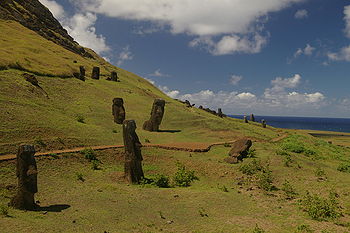
Rano Raraku is a volcanic crater formed of consolidated volcanic ash, or tuff, and located on the lower slopes of Terevaka in the Rapa Nui National Park on Easter Island. It was a quarry for about 500 years until the early eighteenth century, and supplied the stone from which about 95% of the island's known monolithic sculptures (moai) were carved. Rano Raraku is a visual record of moai design vocabulary and technological innovation, where 397 moai remain. Rano Raraku is in the World Heritage Site of Rapa Nui National Park and gives its name to one of the seven sections of the park.
The sides of Rano Raraku crater are high and steep except on the north and northwest, where they are much lower and gently sloping. The interior contains one of the island's three freshwater crater lakes, which is bordered by nga'atu or totora reeds. These plants, once thought as evidence of contact with the South American mainland, are now known to have been growing on the island for at least 30,000 years and were used by the Rapanui for thatched shelter and swimming aids.
The incomplete statues in the quarry are remarkable both for their number, for the inaccessibility of some that were high on the outside crater wall and for the size of the largest; at 21.6 m (71 feet) in height, almost twice that of any moai ever completed and weighing an estimated 270 tonnes, many times the weight of any transported.
Some of the incomplete moai seem to have been abandoned after the carvers encountered inclusions of very hard rock in the material.
Others may be sculptures that were never intended to be separated from the rock in which they are carved.
On the outside of the quarry are a number of moai, some of which are partially buried to their shoulders in the spoil from the quarry. They are distinctive in that their eyes were not hollowed out, they do not have pukao and they were not cast down in the island's civil wars. For this last reason, they supplied some of the most famous images of the island.
Purpose
The largest structures are the great burial platforms, called ahu, (shrines) which supported rows of statues. The ahu were situated on bluffs and in areas commanding a view of the sea. Each ahu was constructed of neatly fitted stone blocks set without mortar. The burial platform supported four to six moai, although one ahu, known as Tongariki, carried 15 moai. Within many of the ahu, vaults house individual or group burials. The function of the moai was to stand on an ahu as representatives of sacred chiefs and gods. Ahu are similar to structures found in the Society Islands, in French Polynesia, where upright stone slabs stood for chiefs. When a chief died, his stone remained.
In addition to representing deceased ancestors, the moai, once they were erected on ahu, may also have been regarded as the embodiment of powerful living or former chiefs and important lineage status symbols.
According to archaeologist Jo Anne Van Tilburg who has studied the moai for many years and is director of the Easter Island Statue Project,[8] the moai statues were not individual portraits but rather standardized representations of powerful individuals or chiefs. She has suggested that their role was both secular and sacred, mediators between the chiefs and their people, and between the chiefs and the gods.[2]
Ahus
Ahu are stone platforms. Varying greatly in layout, many were reworked during or after the huri mo'ai or statue–toppling era; many became ossuaries; one was dynamited open; and Ahu Tongariki was swept inland by a tsunami. Of the 313 known ahu, 125 carried moai—usually just one, probably because of the shortness of the moai period and transportation difficulties. Ahu Tongariki, one kilometer from Rano Raraku, had the most and tallest moai, 15 in total. Other notable ahu with moai are Ahu Akivi, restored in 1960 by William Mulloy, Nau Nau at Anakena and Tahai. Some moai may have been made from wood and were lost.
The classic elements of ahu design are:
- A retaining rear wall several feet high, usually facing the sea
- A front wall made of rectangular basalt slabs called paenga
- A facia made of red scoria that went over the front wall (platforms built after 1300)
- A sloping ramp in the inland part of the platform, extending outward like wings
- A pavement of even–sized, round water–worn stones called poro
- An alignment of stones before the ramp
- A paved plaza before the ahu. This was called marae
- Inside the ahu was a fill of rubble.
On top of many ahu would have been:
- Moai on squareish "pedestals" looking inland, the ramp with the poro before them.
- Pukao or Hau Hiti Rau on the moai heads (platforms built after 1300).
- When a ceremony took place, "eyes" were placed on the Statues. The whites of the eyes were made of coral, the iris was made of obsidian or red scoria.
Ahu evolved from the traditional Polynesian marae. In this context ahu referred to a small structure sometimes covered with a thatched roof where sacred objects, including statues, were stored. The ahu were usually adjacent to the marae or main central court where ceremonies took place, though on Easter Island ahu and moai evolved to much greater size. There the marae is the unpaved plaza before the ahu. The biggest ahu is 220 meters (720 ft) and holds 15 statues, some of which are 9 meters (30 ft) high. The filling of an ahu was sourced locally (apart from broken, old moai, fragments of which have also been used in the fill).[9] Individual stones are mostly far smaller than the moai, so less work was needed to transport the raw material, but artificially leveling the terrain for the plaza and filling the ahu was laborious.
Ahu are found mostly on the coast, where they are distributed fairly evenly except on the western slopes of Mount Terevaka and the Rano Kau and Poike[10] headlands. These are the three areas with the least low–lying coastal land, and apart from Poike the furthest areas from Rano Raraku. One ahu with several moai was recorded on the cliffs at Rano Kau in the 1880s, but had fallen to the beach before the Routledge expedition.[11]
Ahu Tongariki

Ahu Tongariki is the largest ahu on Rapa Nui/Easter Island (a Chilean island in the Pacific). Its moai were toppled during the island's civil wars and in the twentieth century the ahu was swept inland by a tsunami. It has since been restored and has fifteen moai including an 86 tonne moai that was the heaviest ever erected on the island. Ahu Tongariki is kilometer from Rano Raraku and Poike in the Rapa Nui National Park. All the moai here face sunset during Summer Solstice.
Ahu Tongariki was the main centre and capital of the Hotu Iti, the eastern confederation of the Rapanui.[12]
Its moai were toppled during the island's civil wars. In 1960, a tsunami caused by an earthquake off the coast of Chile swept Ahu Tongariki inland.
Ahu Tongariki was substantially restored in the 1990s by a multidisciplinary team headed by archaeologists Claudio Cristino (Director) and Patricia Vargas (Co-director executive team), in a five year project carried out under an official agreement of the Chilean Government with Tadano Limited and the University of Chile.
This ahu is on the south coast of Rapa Nui, close to two previous volcanoes, Rano Raraku and Poike.
Poike is one of the three main extinct volcanoes that form Rapa Nui, which last erupted between 230,000 and 705,000 years ago. Rano Raraku is a volcanic crater formed of consolidated volcanic ash or tuff, which compose the carved moai. Indeed, nearly half (hundreds) of the moai are still buried in the slopes of the Rano Raraku, the main moai quarry. The large, flat plain below Rano Raraku provided easy access to the tuff.
Ahu Akivi

Ahu Akivi is an ahu with seven moai on Rapa Nui (Easter Island) in Chilean Polynesia. The ahu and its moai were restored in 1960 by the American archaeologist William Mulloy and his Chilean colleague, Gonzalo Figueroa García-Huidobro. Mulloy's work on the Akivi-Vaiteka Complex was supported by the Fulbright Foundation and by grants from the University of Wyoming, the University of Chile and the International Fund for Monuments. Ahu Akivi also gives its name to one of the seven regions of the Rapa Nui National Park.
The Moai face sunset during Spring and Autumn Equinox; and have their backs to the sunrise during Spring and Autumn Equinox.
Unlike other ahus, the Akivi-Vaiteka Complex is not located on the coast. In contrast to the monumental statuary at other sites on the island, the moai at Ahu Akivi face the ocean.
Transportation
Experimental archaeology has demonstrated that some moai could have been placed on wooden frames and then pulled to their final destinations. Rapanui traditions metaphorically refer to spiritual power (mana) as the means by which the moai were "walked" from the quarry.
The production and transportation of the 887 statues[13] are considered remarkable creative and physical feats.[14]
Since the island was treeless by the time the Europeans first visited, the movement of the statues was a mystery for a long time; pollen analysis has now established that the island was almost totally forested until 1200 CE. The tree pollen disappeared from the record by 1650, and the statues stopped being made around that time.
It is not known exactly how the moai were moved across the island, but the process almost certainly required human energy, ropes, and possibly wooden sledges (sleds) and/or rollers, as well as leveled tracks across the island (the Easter Island roads).
Oral histories recount how various people used divine power to command the statues to walk. The earliest accounts say a king named Tuu Ku Ihu moved them with the help of the god Makemake, while later stories tell of a woman who lived alone on the mountain ordering them about at her will. Scholars currently support the theory that the main method was that the moai were "walked" upright (some assume by a rocking process), as laying it prone on a sledge (the method used by the Easter Islanders to move stone in the 1860s) would have required an estimated 1500 people to move the largest moai that had been successfully erected. In 1998, Jo Anne Van Tilburg suggested fewer than half that number could do it by placing the sledge on lubricated rollers. In 1999, she supervised an experiment to move a nine-ton moai. They attempted to load a replica on a sledge built in the shape of an A frame that was placed on rollers. A total of 60 people pulled on several ropes in two attempts to tow the moai. The first attempt failed when the rollers jammed up. The second attempt succeeded when they embedded tracks in the ground. This was on flat ground; further experiments may be necessary to determine whether this will work on rougher terrain.[15]
In 1986, Pavel Pavel, Thor Heyerdahl and the Kon Tiki Museum experimented with a five-ton moai and a nine-ton moai. With a rope around the head of the statue and another around the base, using eight workers for the smaller statue and 16 for the larger, they "walked" the moai forward by swiveling and rocking it from side to side; however, the experiment was ended early due to damage to the statue bases from chipping. Despite the early end to the experiment, Thor Heyerdahl estimated that this method for a 20-ton statue over Easter Island terrain would allow 320 feet (100 m) per day. Other scholars concluded that it was probably not the way the moai were moved.[15][16]
Around the same time, archaeologist Charles Love experimented with a 10-ton replica. His first experiment found rocking the statue to walk it was too unstable over more than a few hundred yards. He then found that placing the statue upright on two sled runners atop log rollers, 25 men were able to move the statue 150 feet (46 m) in two minutes. In 2003, further research indicated this method could explain the regularly spaced post holes where the statues were moved over rough ground. He suggested the holes contained upright posts on either side of the path so that as the statue passed between them, they were used as cantilevers for poles to help push the statue up a slope without the requirement of extra people pulling on the ropes and similarly to slow it on the downward slope. The poles could also act as a brake when needed.[17]
1722–1868 toppling of the moai
After the 1722 Roggeveen visit, all of the moai that had been erected on ahus were toppled, with the last standing statues reported in 1838 by Abel Aubert Dupetit Thouars, and no upright statues by 1868,[18] apart from the partially buried ones on the outer slopes of Rano Raraku. Oral histories indicate that this was part of a deadly conflict among the islanders, rather than an earthquake or other cause. Most of the moai were toppled forward to where their faces were hidden and often were toppled in such a way that their necks broke. Today, about 50 moai have been re-erected on their ahus or museums elsewhere.
Removal
Eleven or more moai have been removed from the island and transported to locations around the world, including six out of the thirteen moai that were carved from basalt.
Preservation and restoration
From 1955 through 1978, an American archaeologist, William Mulloy, undertook extensive investigation of the production, transportation and erection of Easter Island's monumental statuary. Mulloy's Rapa Nui projects include the investigation of the Akivi-Vaiteka Complex and the physical restoration of Ahu Akivi (1960); the investigation and restoration of Ahu Ko Te Riku and Ahu Vai Uri and the Tahai Ceremonial Complex (1970); the investigation and restoration of two ahu at Hanga Kio'e (1972); the investigation and restoration of the ceremonial village at Orongo (1974) and numerous other archaeological surveys throughout the island.
The Rapa Nui National Park and the moai are included on the 1994 list of UNESCO World Heritage sites and consequently the 1972 UN convention concerning the protection of the world's cultural and natural heritage.
The EISP (Easter Island Statue Project) is the latest research and documentation project of the moai on Rapa Nui and the artifacts held in museums overseas. The purpose of the project is to understand the figures' original use, context, and meaning, with the results being provided to the Rapa Nui families and the island's public agencies that are responsible for conservation and preservation of the moai.[8]
In 2008, a Finnish tourist chipped a piece off the ear of one moai. The tourist was fined $17,000 in damages and was banned from the island for three years.[19][20]
Early European drawing of moai, in the lower half of a 1770 Spanish map of Easter Island
Notes
- ↑ 1.0 1.1 Jo Anne Van Tilburg, Easter Island: Archaeology, Ecology and Culture (London: British Museum Press, 1994, ISBN 978-0714125046), 24.
- ↑ 2.0 2.1 PBS Nova, Stone Giants Secrets of Easter Island. Retrieved March 22, 2012.
- ↑ Jo Anne Van Tilburg (1994). Easter Island Archaeology, Ecology and Culture. page 146
- ↑ Katherine Routledge (1919) The Mystery of Easter Island ISBN 0-932813-48-8 page 220
- ↑ Steven Roger Fischer, Island at the End of the World: The Turbulent History of Easter Island (London: Reaktion Books, 2006, ISBN 978-1861892829).
- ↑ Katherine Routledge (1919) The Mystery of Easter Island ISBN 0-932813-48-8 page 181
- ↑ Katherine Routledge (1919) The Mystery of Easter Island ISBN 0-932813-48-8 page 186
- ↑ 8.0 8.1 Jo Anne Van Tilburg, What is the Easter Island Statue Project? Easter Island Statue Project. Retrieved March 22, 2012.
- ↑ Heyerdahl 1961
- ↑ Heavy erosion and landslides may have buried them in soil.
- ↑ Cite error: Invalid
<ref>tag; no text was provided for refs namedroutledge - ↑ Fischer 2005 Island at the end of the world ISBN 1-86189-282-9
- ↑ Easter Island Statue Project (2009-05-11). Retrieved 2010-10-16.
- ↑ Rapa Nui National Park
- ↑ 15.0 15.1 History channel "Mega Movers: Ancient Mystery Moves"
- ↑ Easter Island—the mystery solved / Thor Heyerdahl 1989
- ↑ Flenley, John (2003). The Enigmas of Easter Island: Island on the Edge. Oxford University Press. ISBN 0192803409.
- ↑ John Flenley and Paul G. Bahn (2003). The Enigmas of Easter Island: Island on the Edge. ISBN 0192803409.
- ↑ "Easter Island fines ear chipper", BBC News, 2008-04-09. Retrieved 2008-09-21.
- ↑ "Tourist chips earlobe off ancient statue on Easter Island", Globe and Mail, 2008-04-09. Retrieved 2008-09-21.
ReferencesISBN links support NWE through referral fees
- Bahn, Paul, and John Flenley. The Enigmas of Easter Island. New York, NY: Oxford University Press, 2003. ISBN 978-0192803405
- Fischer, Steven Roger. Island at the End of the World: The Turbulent History of Easter Island. London: Reaktion Books, 2006. ISBN 978-1861892829
- Hunt, Terry, and Carl Lipo. The Statues that Walked: Unraveling the Mystery of Easter Island. New York, NY: Free Press, 2011. ISBN 978-1439150313
- Matthews, Rupert. Ancient Mysteries (Unexplained). London: QEB Publishing, 2011. ISBN 978-1595668547
- Pelta, Kathy. Rediscovering Easter Island: How History Is Invented. Minneapolis, MN: Lerner Publishing Group, 2001. ISBN 978-0822548904
- Peregrine, Peter N., and Melvin Ember (eds.) Encyclopedia of Prehistory, Volume 3: East Asia and Oceania. New York, NY: Kluwer Academic/Plenum Publishers, 2001. ISBN 978-0306462573
- Routledge, Katherine. The Mystery of Easter Island. New York, NY: Cosimo Classics, 2007 (original 1919). ISBN 978-1602066984
- Van Tilburg, Jo Anne. Easter Island: Archaeology, Ecology and Culture. London: British Museum Press, 1994. ISBN 978-0714125046
- Van Tilburg, Jo Anne. Hoa Hakananai'a. London: British Museum Press, 2004. ISBN 978-0714150246
- Van Tilburg, Jo Anne. Remote Possibilities: Hoa Hakananai'a and HMS Topaze on Rapa Nui. London: British Museum Press, 2006. ISBN 978-0861591589
- Mulloy, W.T. 1968. Preliminary Report of Archaeological Field Work, February-July, 1968, Easter Island. New York, N.Y.: Easter Island Committee, International Fund for Monuments.
- Mulloy, W.T., and G. Figueroa. 1978. The A Kivi-Vai Teka Complex and its Relationship to Easter Island Architectural Prehistory. Honolulu: Social Science Research Institute, University of Hawaii at Manoa.
- Mulloy, W.T., and S.R. Fischer. 1993. Easter Island Studies: Contributions to the History of Rapanui in Memory of William T. Mulloy. Oxford: Oxbow Books.
- Mulloy, W.T., World Monuments Fund, and Easter Island Foundation. 1995. The Easter Island Bulletins of William Mulloy. New York; Houston: World Monuments Fund; Easter Island Foundation.
- Norwegian Archaeological Expedition to Easter Island and the East Pacific, T. Heyerdahl, E.N. Ferdon, W.T. Mulloy, A. Skjølsvold, C.S. Smith. 1961. Archaeology of Easter Island. Stockholm; Santa Fe, N.M.: Forum Pub. House; distributed by The School of American Research.
- P.E. Baker (1968) "Preliminary Account of Recent Geological Investigations on Easter Island." Geological Magazine 104 (2): 116-122
- J.R. Flenley, S.M. King, J.T. Teller, M.E. Prentice, J. Jackson and C. Chew (1991). "The Late Quaternary Vegetational and Climatic History of Easter Island." Journal of Quaternary Science 6:85-115.
- Jo Anne Van Tilburg (1994). "Easter Island Archaeology, Ecology and Culture." London and Washington, D.C. British Museum Press and Smithsonian Institution Press ISBN 0-7141-2504-0 http://www.sscnet.ucla.edu/ioa/eisp/
- Alfred Metraux [1]
External links
- Moai of Rapa Nui (Easter Island, Chile) - Britton Shepardson
- Easter Island Statue project
- PBS NOVA: Secrets of Easter Island
- PBS NOVA: Secrets of Lost Empires: Easter Island
- Czech who made moai statues walk returns to Easter Island
- Ahu Tongariki Restoration project
- Unofficial Easter Island Homepage
- Easter Island Statue project
- How to make Walking Moai: a hypothesis about how Moai were transported
- Czech who made Moai statues walk returns to Easter Island
- History of Easter Island stones
- Easter Island - Moai Statue Scale
- University of Chile
- 360° Panoramas dedicated web site of Easter Island
- Rapa Nui Fact Sheet with Photographs
- Rapa Nui Photo Gallery
- The Statues and Rock Art of Rapa Nui
- University of Wyoming Outstanding Former Faculty
- Unofficial Easter Island Homepage
- Easter Island Statue Project
- Nova: The Secrets of Easter Island
- Easter Island - Moai Statue Scale
- How to make Walking Moai
- Czech Who Made Moai Walk Returns to Easter Island
Credits
New World Encyclopedia writers and editors rewrote and completed the Wikipedia article in accordance with New World Encyclopedia standards. This article abides by terms of the Creative Commons CC-by-sa 3.0 License (CC-by-sa), which may be used and disseminated with proper attribution. Credit is due under the terms of this license that can reference both the New World Encyclopedia contributors and the selfless volunteer contributors of the Wikimedia Foundation. To cite this article click here for a list of acceptable citing formats.The history of earlier contributions by wikipedians is accessible to researchers here:
The history of this article since it was imported to New World Encyclopedia:
Note: Some restrictions may apply to use of individual images which are separately licensed.
